WPT has joined forces with the Alliance to Counter Crime Online and a raft of wildlife conservation and welfare groups to call for wildlife trafficking and animal cruelty to be included within the UK’s Online Safety Bill. The Online Safety Bill, which is currently making its way through Parliament, is a landmark piece of legislation that will place the UK are the forefront of the regulation of online platforms. The Bill will require tech companies to put in place measures to address crimes taking place on their platforms and we're is calling on law-makers to treat illegal sales of endangered wildlife on a par with sales of drugs, firearms and people.
WPT's research into the trade in parrots has revealed how online platforms facilitate wildlife trafficking and the need for meaningful regulation. And we have ensured this information gets in front of those who matter, briefing ministers, MPs and Lords, including the UK Minister for the Environment at Paradise Park last year. Follow us on social media to learn more.
Now WPT is asking members of the public to write to Michelle Donelan, Secretary of State for Science, Innovation and Technology, to tell her why it is important wildlife trafficking and animal cruelty offences are included within the Online Safety Bill. Details on how to contact Michlle Donelan can be found https://members.parliament.uk/member/4530/contact.
Please write and let the government know how important this is to you.
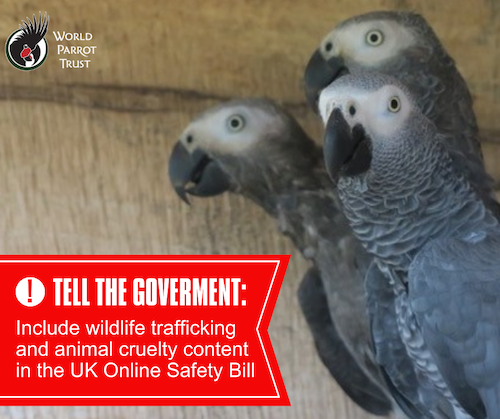
by: Sascha Dueker, WPT Lovebird Conservation Coordinator.
GENETICS, STATUS SURVEY, HUMAN-WILDLIFE CONFLICT AND TRADE IN TANZANIA
As promised in the previous blog, the lovebird journey continues in 2022 with exciting and important projects involving Fischer’s and Masked Lovebirds, the two species well known as companion birds. In August and September, I travelled to Tanzania to collaborate with a local team to collect samples and field data to understand more about the lives of these two charismatic species in the wild and the threats they face.
1. GENETICS AND HYBRIDIZATION
Following on from sampling Black-cheeked and Lilian’s Lovebirds in the Zambezi River basin in southern Africa, we were aiming to collect genetic samples of Fischer’s and Masked Lovebirds, which call eastern Africa their home. Sampling these populations would complete the sampling of all wild populations of the “eye-ring” species. To make this project happen we teamed up with NatureTanzania, Attraction Birds Conservation and the Tanzania BirdAtlas Project who’s support was vital to its success. Such collaboration enabled the composition of a highly specialized research team going on a journey to remote areas in which these birds are found. With huge success! In total over a hundred samples from 9 different populations were taken. Once these samples have been processed in the lab in South Africa, the data will give us a unique opportunity to identify relationships between populations, species and generate insights into the extent of hybridization that occurs due to human impacts on land cover alterations as well as escaped birds from the trade. This work will help understand more about the extent of hybridisation between these two species due to the loss of a natural barrier once separating them. Could there be undescribed lovebird species out there? What will the genetic codes reveal?
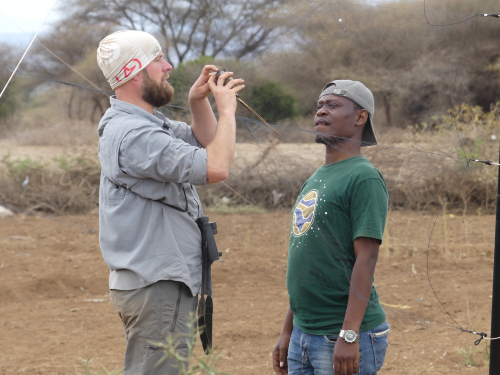
Lovebird Conservation Coordinator Sascha Dueker and Michael Jaka from University Dar Es Salaam at a mist net setup to sample Lovebird DNA.

A Fischer's Lovebird already sampled for it's DNA, rung with color identifiable rings, and ready for release back to join it's flock.
2. STATUS SURVEYS AND ECOLOGY
A second aim of the expedition was to collect preliminary information on the conservation status of populations and understand the extent of threats including habitat loss, persecution as a crop pest and capture for the pet trade. Although we were aware that Fischer’s lovebirds are persecuted as crop pests in some areas, the scale and nature of this practice was nevertheless shocking. Fischer's Lovebirds were reported to be persecuted and poisoned in large numbers with pesticides being systematically deployed from airplanes targeting roost sites. We urgently need to find out more on the impacts of this measure for lovebirds and humans living in those areas. In collaboration with Franz Maier, a student at Georg-August University Göttingen, we have initiated data collection of Fischer’s Lovebirds in areas outside the formally protected area network to get an understanding of their numbers, as well as find out more about their ecological requirements and the impact of persecution. This work will follow up on surveys conducted in these areas in 1993 to understand changes over the last three decades.
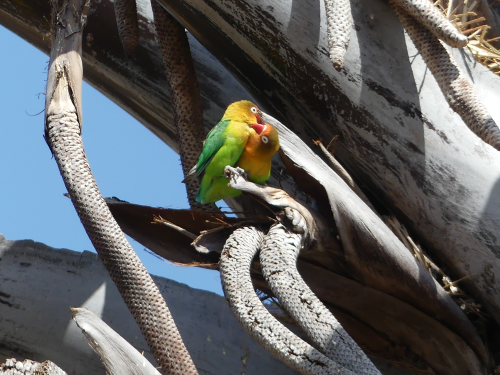
A pair of Fischer's Lovebirds in a Borassus palm tree in which they were found roosting and nesting.
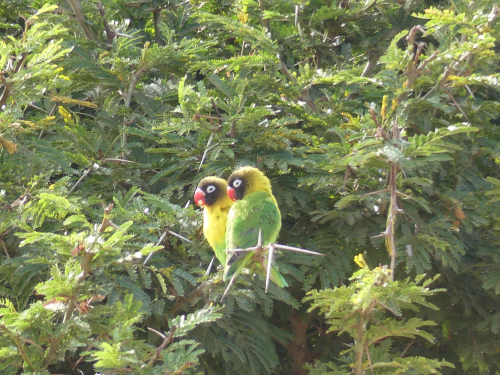
A pair of Masked Lovebirds perching and resting in the morning sun in the safety of a thorny Acacia tree.
3. HUMAN-WILDLIFE CONFLICT AND TRADE
To understand more about the socio-economic dimensions of conflict between people and lovebirds and seek solutions that benefit both people and nature we are collaborating with Michael Jaka, a student from University Dar Es Salaam. Michael’s project will also look into the scale and scope of capture and trade. In the 1980-90s the Fischer’s Lovebird was one of the globally most caught and exported wild birds for the pet trade but policy measures brought in in the 1990s restricted exports. Since that time no data exists on the extent of capture. The team encountered lovebirds being sold at the roadside on several occasions. Michael will collect further information on these two threats and the ways they intersect in the upcoming weeks.
The initial genetic sampling trip was successful but flagged several conservation concerns which are being investigated further. We would like to express our sincere thanks to all our partners making research and further investigation and protection of these charismatic birds possible. Partners include University Dar Es Salaam, Georg August Universität Göttingen, NatureTanzania, Attraction Birds Conservation, and Tanzania BirdAtlas Project. Funding was provided by Natural Encounters Conservation Fund (NECF), Gesellschaft für Arterhaltende Vogelzucht e.V. (GAV), Gesellschaft für Tropenornithologie e. V. (GTO), African Bid Club (ABC), Lovebird Valentine's Campaign 2022, a generous gift from Pamela Isdell, Swissline Cosmetics, International Foundation for Science and BirdLife International/Good Gifts catalogue. We thank YOU as well as our partners and collaborators for ongoing success.
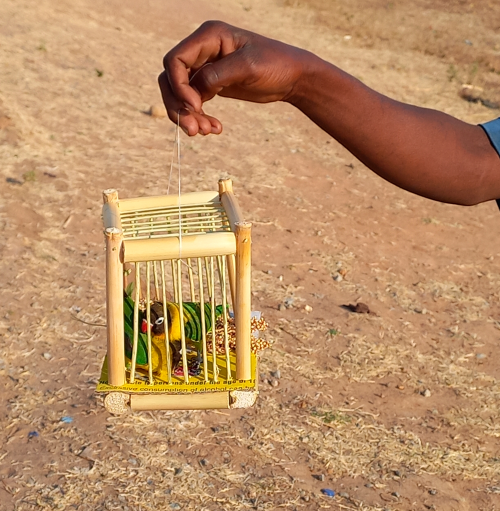
A pair of wild-caught Masked Lovebirds being illegaly sold at the site of the road.
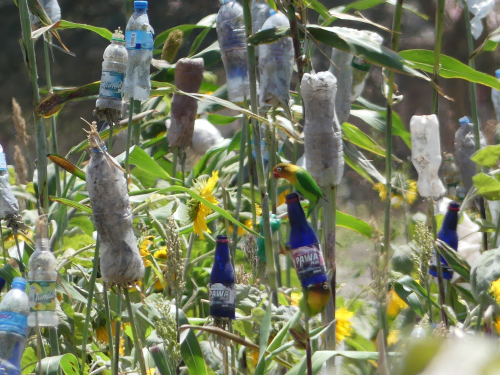
Fischer's Lovebirds being creative when it comes to getting their food. Even protecting the Sorghum with plastic bottles does not stop these smart birds from getting their afternoon snack.
Click here if you like to support Lovebirds in the wild. Thank you!

